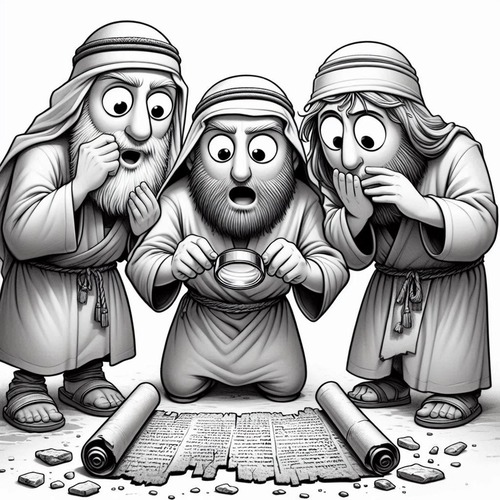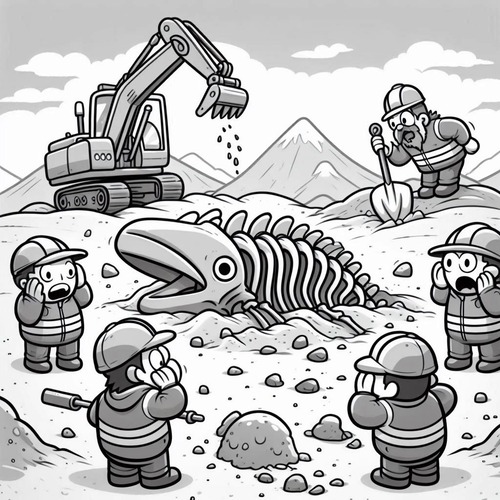Did Jesus Cleanse the Temple Twice?
OR DID JOHN DISAGREE WITH THE SYNOPTICS ON TIMING?
One of sceptics’ favourite “gotcha” questions targets what they see as a clear contradiction in the Gospels. John places Jesus’ temple cleansing at the very beginning of His ministry (John 2:13-22), while Matthew, Mark, and Luke all describe it happening during Passion Week, just days before the crucifixion (Matthew 21:12-17; Mark 11:15-19; Luke 19:45-48).
“See?” critics argue, “The Gospel writers can’t even agree on when this major event happened. How can we trust anything they say?”
But the supposed contradiction actually strengthens rather than weakens our confidence in Scripture’s reliability. Reformed scholarship has provided compelling answers that preserve biblical inerrancy while explaining the textual evidence with remarkable clarity.
THE TWO-CLEANSING SOLUTION: WHY IT MAKES PERFECT SENSE
Did Jesus Cleanse the temple twice? The overwhelming majority of Reformed scholars, from John Calvin to modern commentators, argue Jesus cleansed the temple twice—once at the beginning of His ministry and again at the end. Far from being a desperate attempt to rescue the text, this interpretation flows naturally from the evidence.
Consider the practical reality: Jesus’ ministry lasted over three years. The temple’s corruption wasn’t a one-time problem that could be solved with a single dramatic intervention. The religious establishment had created a lucrative system that turned God’s house into “a den of thieves.” Would one cleansing really reform such an entrenched, profitable enterprise?
History suggests otherwise. Corrupt systems don’t reform easily—they revert to old patterns once the reformer leaves. The temple merchants likely resumed their exploitation within weeks of the first cleansing, necessitating a second, more decisive confrontation.
THE EVIDENCE POINTS TO TWO DISTINCT EVENTS
When we examine the Gospel accounts carefully, we find significant differences that suggest two separate occasions rather than conflicting reports of the same event.
- The Setting and Tone: John’s account occurs during Passover at the ministry’s beginning, with Jesus declaring, “Make not my Father’s house a house of merchandise” (John 2:16). The Synoptic accounts happen during the final Passover, with Jesus using harsher language: “My house shall be called a house of prayer, but you make it a den of thieves” (Matthew 21:13).
- The Responses: In John’s account, the Jews ask for a sign to prove Jesus’ authority. In the Synoptic accounts, the chief priests and scribes immediately begin plotting Jesus’ death—a response that makes perfect sense if this was the second such disruption from this ‘troublesome’ teacher.
- The Disciples’ Reactions: John records the disciples remembering Psalm 69:9—”Zeal for your house will consume me”—while the Synoptics focus on Jesus’ teaching and the authorities’ murderous response.
These aren’t contradictory accounts of the same event; they’re complementary accounts of related but distinct confrontations.
ADDRESSING SCEPTICS’ OBJECTIONS
“But why don’t the Synoptic writers mention the early cleansing?” sceptics ask. This objection reveals a fundamental misunderstanding of ancient biography. Each Gospel writer selected events that served their particular theological purposes. John includes unique material not found in the other Gospels throughout his account—the wedding at Cana, the conversation with Nicodemus, the woman at the well. Should we consider these to be fabrications simply because the other writers don’t mention them?
“Wouldn’t Jesus use different words and actions if these were separate events?” Again, this misses the mark. Teachers naturally repeat effective language when addressing similar situations. A pastor confronting financial corruption in his church might use similar biblical language each time the problem resurfaces. Consistency in Jesus’ words and actions across similar situations actually supports authenticity rather than undermining it.
THE THEOLOGICAL SIGNIFICANCE
Whether we accept one cleansing or two, both accounts powerfully demonstrate Christ’s divine authority over temple worship. The progressive escalation from “house of merchandise” to “den of thieves” shows the hardening of religious corruption and Jesus’ increasingly direct confrontation with it.
This isn’t merely about chronology—it’s about Christ’s messianic mission to purify worship and judge religious hypocrisy. The temple cleansings foreshadow the ultimate judgment that would fall on the corrupt religious system in AD 70.
REFORMED SCHOLARS: UNITED ON RELIABILITY, NUANCED ON DETAILS
So, did Jesus cleanse the temple twice? Reformed scholarship presents a compelling consensus while allowing for scholarly nuance. The majority position, championed by John Calvin, Matthew Henry, RC Sproul, and DA Carson, strongly defends the view that the most natural reading of the text suggests the cleansing happened twice.
However, some respected evangelical scholars offer alternative approaches while maintaining complete confidence in Gospel reliability. Leon Morris, the distinguished New Testament scholar, leaned toward a single cleansing but acknowledged the difficulty of the chronological question. Herman Ridderbos emphasised the Gospel writers were more concerned with theological significance than strict chronological sequence. He suggested John may have placed the cleansing early to introduce Jesus’ authority theme. Craig Blomberg, while open to both possibilities, notes that ancient biographers commonly arranged material thematically rather than chronologically.
Significantly, even these scholars who question the two-cleansing solution unanimously affirm the Gospel accounts are completely reliable and mutually consistent when properly understood within the conventions of ancient biographical writing.
CONCLUSION: STRENGTH, NOT WEAKNESS
Far from representing a biblical contradiction, the temple cleansing accounts demonstrate the Gospels’ historical reliability. The writers weren’t copying from each other or inventing details—they were recording real events from different periods in Jesus’ ministry.
This supposed “problem” actually becomes powerful evidence for the Gospels’ trustworthiness. When independent witnesses record similar but distinct events with different details and emphases, it strengthens rather than weakens their credibility.
The temple cleansing question doesn’t undermine Scripture’s authority—it showcases the careful, truthful reporting of the Gospel writers and the consistent character of our Lord, who confronted corruption whenever and wherever He found it.
DID JESUS CLEANSE THE TEMPLE TWICE? RELATED FAQs
What did John Calvin believe about the temple cleansing? Calvin firmly believed Jesus cleansed the temple twice during His ministry. In his commentary on John’s Gospel, he argued the differences in timing, language, and circumstances clearly indicate two separate events. Calvin reasoned the temple corruption was so entrenched that one cleansing wouldn’t permanently solve the problem. He saw the early cleansing as Jesus announcing His messianic authority, while the later cleansing was His final judgement on the corrupt religious system.
- How did RC Sproul address this question? Sproul consistently defended the two-cleansing position throughout his teaching ministry. He emphasised Jesus’ three-year ministry provided ample opportunity for temple corruption to return after the initial cleansing. Sproul argued that the different responses—Jews asking for a sign in John versus immediate murderous plots in the Synoptics—clearly indicate separate occasions. He viewed attempts to harmonise these as one event as unnecessary and forced.
- What was Matthew Henry’s position on the temple cleansings? Henry supported the two-cleansing view in his Bible commentary. He noted the temple merchants would naturally resume their profitable corruption once Jesus left, making a second cleansing both necessary and expected. Henry saw theological significance in both events: the first demonstrated Christ’s zeal for pure worship, while the second revealed His authority to judge religious hypocrisy. He argued Jesus’ consistent opposition to temple corruption across His ministry actually strengthened the Gospel accounts’ credibility.
How does Don Carson explain the temple cleansing accounts? DA Carson, in his respected commentary on John’s Gospel, argues for two distinct cleansings based on careful textual analysis. He points to significant differences in details, timing, and responses that suggest separate events rather than conflicting reports. Carson emphasises Jesus’ repeated confrontation with temple corruption demonstrates consistent character rather than Gospel confusion. He notes ancient biographers commonly recorded multiple similar events when they served their narrative purposes.
- What was Herman Ridderbos’ approach to this question? Ridderbos took a more nuanced approach, emphasising that Gospel writers prioritised theological themes over strict chronological sequence. While not definitively choosing between one or two cleansings, he suggested John may have placed the temple cleansing early to introduce Jesus’ authority theme from the ministry’s beginning. Ridderbos argued understanding ancient biographical methods resolves apparent chronological difficulties. He maintained both interpretations preserve complete Gospel reliability when properly understood.
- How did Leon Morris handle the temple cleansing timeline? Morris leaned toward a single temple cleansing while acknowledging the genuine difficulty of the chronological question. He suggested John may have arranged his material thematically rather than chronologically, placing the cleansing early for theological reasons. However, Morris emphasised that ancient biographers had different conventions from modern historians, and apparent chronological discrepancies don’t undermine Gospel reliability. He remained open to the two-cleansing solution while preferring the single-event interpretation.
What is Craig Blomberg’s view on the temple cleansing accounts? Blomberg remains genuinely open to both the one- and two-cleansing solutions, considering both interpretively valid. He emphasises ancient biographers commonly arranged material thematically rather than strictly chronologically, which explains apparent timing differences. Blomberg argues either interpretation preserves Gospel reliability when we understand first-century biographical conventions. He notes the core theological message—Christ’s authority over temple worship—remains the same regardless of whether the cleansings were one event or two.
DID JESUS CLEANSE THE TEMPLE TWICE? OUR RELATED POSTS
- Sacred Fury: What Christ’s Temple Cleansing Truly Means
- Bible ‘Contradictions’: Not Quite Hurdles to Faith
Editor's Pick

Does God Know the Future? All of It, Perfectly?
Think about this: our prayers tell on us. Every time we ask God for something, we’re confessing—often without realising it—what [...]

Can Christian Couples Choose Permanent Birth Control?
Consider Sarah, whose fourth pregnancy nearly killed her due to severe pre-eclampsia, leaving her hospitalised for months. Or David and [...]

Bone of My Bones: Why Eve Was Created From Adam’s Body
"This at last is bone of my bones and flesh of my flesh!" Adam's joyful exclamation upon first seeing Eve [...]

Is Calvinism Fatalism in Christian Disguise? Think Again
We hear the taunt every now and then: "Calvinism is just fatalism dressed up in Christian jargon." Critics argue Reformed [...]

Can Churches Conduct Same-Sex Weddings?
In an era of rapid cultural change, churches across America face mounting pressure to redefine their understanding of marriage. As [...]

Gender Reassignment: Can Christian Doctors Perform These Surgeries?
In the quiet of a clinic, a Christian physician faces a challenging ethical question. A patient sits across the desk, [...]

‘What Sorrow Awaits You Who Are Rich…’: What Does Jesus Mean?
The words hang in the air like a sword over comfortable Christianity: “What sorrow awaits you who are rich, for [...]

Does the Bible Clearly Teach the Deity of Christ?
Critics argue Jesus never explicitly claimed to be God. Others suggest the doctrine emerged centuries later through philosophical speculation. But [...]

The Holy Spirit’s Indwelling: How Can I Be Sure I Have It?
“Am I truly saved? How can I know for certain that the Holy Spirit lives within me?” If you’ve wrestled [...]

Did Mary Remain a Virgin? A Biblical Case Against Perpetual Virginity
The question of Mary’s perpetual virginity has divided Christians for centuries. While Catholic and Orthodox traditions affirm Mary remained a [...]
SUPPORT US:
Feel the Holy Spirit's gentle nudge to partner with us?
Donate Online:
Account Name: TRUTHS TO DIE FOR FOUNDATION
Account Number: 10243565459
Bank IFSC: IDFB0043391
Bank Name: IDFC FIRST BANK






